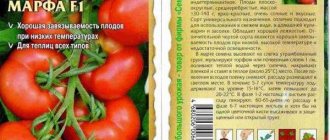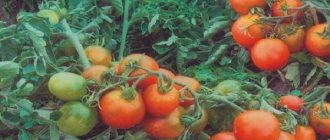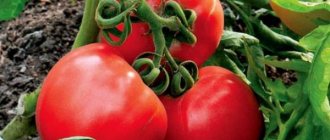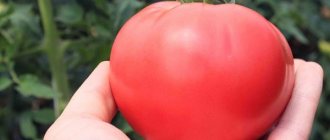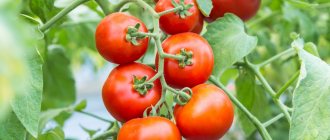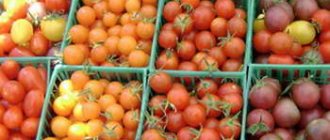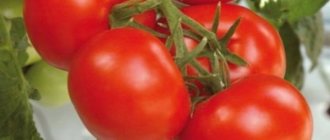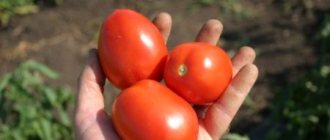The early ripening Leningrad tomato will appeal to gardeners and farmers in regions where the summer is cool and short. The variety is intended for northwestern areas. It has many undeniable bonuses - high productivity, excellent taste, simple agricultural technology.
| Height | Landing location | Ripening time | Fruit color | Fruit size | Origin | Fruit shape |
| short | Greenhouse, Open ground | Early ripening | Reds | Average | Variety | Round |
Description and characteristics of the variety
The Leningradsky early ripening tomato is a determinate, low-growing variety. The bushes are low, standard, and do not exceed 30 cm in height. They do not require pinching or pinching. In greenhouse conditions they can grow up to 60-80 cm. 11-13 tomatoes are tied on fruiting clusters.
Early ripening - begins on the 20th of July, 90-95 days from germination.
Description of tomatoes:
- average weight 50-70 g;
- round shape;
- watermelon pulp, fleshy;
- the taste is sweetish with a slight sourness;
- the skin is strong;
- sugar level 3-3.5%;
- dry matter index 7-7.5%;
- ribbing is weakly expressed.
The fruits are prepared into salads and canned whole. Tomatoes are processed into juice, paste, and ketchup.
Tall tomatoes for the greenhouse
There are must-have varieties that I always plant every year. I like them not only for their taste and unpretentiousness, but also for the way they look on the bush. I’ll paraphrase one bearded joke: “I don’t really like tomatoes... But the process itself...”. I love going into the greenhouse and admiring the tomato plantations. And I don’t hesitate to show off my particularly spectacular huge tomatoes to my neighbors, and then post photos on the forum. It’s a shame to hide it – we all love it!
The following varieties are among the favorites also because they do not need to be fanatically cultivated and shaped. And they will always give a harvest: small, large, and a lot, depending on the variety and what I grow them for - for salads, for preparations, or, the smallest and sweetest ones, so that “like seeds, they click.” .
The “Rocket” variety is suitable for both greenhouses and open ground. The fruits are identical in shape and sweet. We love to eat them by the handful. Look good in blanks. The bush requires garter, despite the fact that the package says the opposite. This is because a lot of fruits grow, and the bush bends from the weight. Its height in open ground is about 40 cm, and in a greenhouse it can reach up to 60 cm. This is a mid-season variety; it does not need to be pinched.
Rice. 1. “Rocket” matures smoothly and is well stored in both technical and biological maturity.
I got the “Big Man” variety from a neighbor. During a tour of her greenhouse, I really liked the way it looked on the bush. The neighbor said that she has been planting it for a long time, that it is unpretentious and always sets fruit, even if the ventilation regime in the greenhouse is not followed. Of course, I took one fruit for seeding. “Zdorovyak” can grow up to 100 cm in height, so it is better to grow it in a greenhouse, although it produces large tomatoes in open ground.
Rice. 2. There is almost no need to pin the “Big Man” wrist.
Rice. 3. It ripens in batches, gradually, which is very convenient.
Among the vigorous-growing tomatoes with large fruits, I singled out the “Red Giant” variety. This amateur variety was bred by simple gardeners. Despite the fact that it grows a lot of leaves, it does not have to be pruned too often. The fruits on the lower tiers are the largest. If I had not been lazy and plucked out the inflorescences, leaving no more than 3-4 in the brush, the fruits would have been even larger. It is fleshy inside and contains few seeds.
Rice. 4. “Red Giant” in mid-July.
Rice. 5. You can take your own seeds, but the fruit must ripen on the bush and come from the second cluster from the bottom.
Rice. 6. The fruits are slightly ribbed, quite transportable, there is never a yellow-pink top from unbalanced care, as in pink-fruited varieties.
Rice. 7. Both the side of the stalk and the reverse side always have a marketable appearance.
Rice. 8. The only drawback of the “Red Giant” is that the largest fruits require a garter.
However, almost all large-fruited tomatoes require additional tying of the brushes. Except for my next favorite, Bull's Heart. I also always grow it year after year, as my grandmother advised me. “He will never let you down!” - she said, and every year I am convinced of this. Even if I took my own seeds and not factory ones, “Bull’s Heart” invariably bears fruit and does not require pinching at all, although it is vigorous.
Rice. 9. The hands grow in such a way that they do not need to be additionally secured with a garter to prevent them from falling.
Rice. 10. There is one feature of the “Bull’s Heart” - a predisposition to the formation of such gnarled fruits.
Therefore, if you see a bud or flower that is too large, feel free to cut it with scissors, it will still take a long time to ripen, even though it will be large, the skin will be hard and gray, you cannot take seeds from it.
Rice. 11. But the bulk of the “Bull’s Heart” fruits are very beautiful, tasty and fleshy. By the way, this variety comes in both orange and red.
I definitely plant the listed varieties, but there are also some that I just liked, and I periodically grow them in the greenhouse, but I have not become a fan of them. Of the indeterminates, I like the raceme varieties the most. Again, this is primarily because they look beautiful on the bush. There are only three varieties, and each has a special reason to grow it.
“Intuition F1” is a mid-season hybrid, but I would classify it as a late-season hybrid. Not only does it reach harvest ripeness only by mid-August, but biological maturity also comes quite late. Some specimens of these tomatoes ripen even until the end of October. But, on the other hand, this is convenient because as a result, we have our own fresh tomatoes at home for a very long time. That's why I sow it in February.
Rice. 12. Photo from the end of July, but the fruits have not yet begun to ripen.
But “Intuition F1” is very easy. This hybrid is great for freezing for future use. In winter, I make pizza and frittata with them, as they do not defrost like porridge, but retain their meatiness well when cut.
Rice. 13. The fruits are all smooth and beautiful.
Rice. 14. In this form, I send “Intuition F1” to deep freeze.
“Scarlet Candles” is a cluster variety, mid-season. They don’t have a special taste, but what a shape! Looks impressive in preparations with cucumbers. However, this is why I grow them. It’s nice to admire such a jar later in the winter.
Rice. 15. The length of “Scarlet Candles” is almost like pickling cucumbers.
Rice. 16. “Scarlet candles” look neat, they all have a characteristic “spout”.
“De Barao” is quite late-ripening; I sow it earlier than the bulk of tomatoes. I really like it in preparations, it does not crack and is very tasty, both fresh and pickled.
Rice. 17. "De Barao" is resistant to disease. I always plant it on the north side, tying it above the entrance to the greenhouse, because it is very tall, and the upper tier ripens even in the last ten days of August, despite the first cold nights.
Rice. 18. The fruits are beautiful, all as one.
I have tried a great variety of salad varieties, I still want to find the most delicious one. Of the unusually colored tomatoes, I really like the taste of “Malachite Box” and “Black Prince”. Both are tall and require pinching, gartering, and formation into 1-2 stems, but the effort is worth it, the fruits are magnificent. “Black Prince” is dark burgundy when fully ripe.
Rice. 19. “Malachite box” in biological maturity – green.
Rice. 20. All these “Malachite Box” tomatoes are already ripe, although in appearance they seem unripe.
The yellow giants are not inferior in taste, of which the most fleshy and tasty for me are “Yellow Truffle” - of an unusual shape, “Persimmon” - indeed, the pulp is cut like the fruit of the same name, “Golden King” and sweet as a melon, “ Golden Bull." “Golden Heart” and “Altai Yellow” were less impressive. But it should be noted that the shelf life of yellow tomatoes is inferior to red ones.
Rice. 21. Everyone looks the same on the bush. This is Cardinal.
Rice. 22. “Cardinal” is well kept.
Rice. 23. "Canaries".
Rice. 24. In the foreground is “Mazarin”. It differs only in shape, in taste - like all other red-fruited ones.
Rice. 25. “Altai Reds”, however, can be praised for their friendly maturation.
Separately, I would like to mention the pink-fruited tomatoes “Miracle of the Earth”. If you are lucky with the summer and it is not very hot, then you can get a good harvest from this variety.
Rice. 26. “Miracle of the Earth” are also tall.
But, if there is not very good ventilation in the greenhouse, then this variety will give a characteristic light yellow border, I don’t like it, and I cut it off before use.
Rice. 27. “Miracle of the Earth” - on the right. They are the same size as the Red Giant on the left.
Separately, it should be said about tall cherry tomatoes, for example, “Chio-chio-san”, “Sweet Cherry F1” and others. Yes, many of them are sweet, they look elegant both in the greenhouse and in pickles, but many of them are thrown away and require careful care. No matter how much I refuse to plant them, I still “break down”, I really want to admire the brushes.
Rice. 28. “Red date” is, of course, delicious.
Rice. 29. “Goldilocks” also tastes good if you resist and don’t eat it half-ripe - and it can be eaten even half-ripe.
The homeland of tomatoes is South America. Plants that require heat and light do not tolerate unfavorable climate conditions. Over the years of cultivating tomatoes in our country, breeders have developed many varieties adapted to the weather conditions of Russia. But the best results can be obtained in greenhouses.
Preparing the greenhouse for planting tomatoes begins in the fall with disinfection of the room. Shelters with a wooden frame are fumigated from the inside with sulfur, after caulking the cracks. This is done like this:
- Sulfur is mixed with kerosene, laid out on iron sheets and set on fire.
- The doors are closed tightly, leaving the mixture to smolder. Experienced gardeners recommend keeping it for 5 days. This period is enough for fungal and mold spores to die. Sulfur smoke is also harmful to insect larvae.
Premises with a metal base are sprayed with a solution of chlorinated lime diluted in water. Take 400 grams of the substance into a ten-liter bucket and leave it to infuse for 5-6 hours. After the solution is ready, it is sprayed onto the soil, ceiling and walls of the greenhouse. After treatment, the structure should remain closed for 2-3 days.
When the treatment is completed, the greenhouse is ventilated and thoroughly washed. The metal frame is poured with a large amount of boiling water, and the wooden frame is spilled with a solution of copper sulfate.
Soil preparation
The soil for tomatoes also needs to be prepared in advance. It is advisable to change it every 3-5 years, otherwise it will become depleted and you will not be able to get a good harvest. To do this you need:
- remove the top layer to a depth of 4-5 cm;
- fill in new soil;
- feed with compost at the rate of 10 kg per square meter;
- When digging, enrich the soil with phosphorus and potassium fertilizers.
After the area for tomatoes has been dug up, it is covered with straw. To make the ground freeze less, you can throw snow on it. Having melted, it will well moisten future beds. In the spring, the soil in the greenhouse is loosened with a pitchfork, without turning the layer, while simultaneously enriching it with nitrogen.
| Variety: | early ripening |
| Determinacy: | determinant |
| Sowing seedlings: | April |
| Transplanting into the ground: | May June |
| Harvesting: | July August |
| Soil type: | open |
| Fetal weight: | 50-60 g |
| Fruit shape: | rounded |
| Fruit color: | red |
| Packing: | 25 pcs |
Planting and care
The bushes are transplanted into beds at the age of 50-55 days.
5-6 plants are placed per 1 m2.
Subtleties of caring for tomatoes:
- moderate watering 2 times a week, the norm is 4-5 liters at the root;
- garter to a low support;
- fertilizing with liquid organic matter and phosphorus-potassium mixtures.
Ripe tomatoes can be stored for up to 4 weeks in the dark and cool.
Recommended tomato varieties
Early maturing / Low growing
Non-stick orange with spout User rating: 4/5
Mid-season / Low-growing
Tsar Peter User rating: 5/5
Early maturing / Low growing
General F1 User rating: 5/5
Early maturing / Low growing
Baby Four Summer User rating: 5/5
How to choose tomatoes for the Leningrad region
The area is characterized by frequent precipitation, high clouds and an extended, cold spring. Return frosts can occur in early June; summer is short and the weather is unstable. The morning may be warm and sunny, there will be a shower in the afternoon, and the evening will begin with gusty winds that will persist until the next day.
Attention!
In the northwest, due to the short summer, gardeners plant only early and mid-early tomatoes. Especially if you plan to plant in unprotected beds or under film.
Summer residents who have the opportunity to grow crops in a greenhouse have nothing to worry about, but owners of small gardens will have to set up greenhouses or organize film shelters. There are few varieties that can be planted in open beds for this area. As in other regions of Russia, tomatoes are cultivated by seedlings, but with one obligatory condition - the seedlings need to be hardened off.
In addition to the ripening period and immunity to negative factors, gardeners pay attention to such characteristics as yield and fruit size. Large tomatoes in unheated greenhouses, greenhouses, and open beds do not have time to fully ripen before a significant fall in temperature. Some fruits do not even reach technical maturity, which makes them unsuitable for ripening and pickling (an unpleasant bitterness remains).
Reviews
- Nikusha Azimov, 53 years old:
I have been growing different varieties of tomatoes for a long time. I like the Leningradsky early ripening tribe for the early production of ripe and tasty tomatoes, as well as for their ease of care. Low-growing bushes wonderfully tolerate temperature changes. The fruiting period begins at the end of June and may decrease until the end of August. - Varvara Mikhailovna, 61 years old:
In my dacha, I always try to plant early-ripening vegetables, because I always want to get fresh vegetables from the garden early. I have been planting the Petersburg variety every year for about 5 years now. I like its unpretentiousness and compactness. The slightly sour taste of the fruit emphasizes the relish of any dish. Mostly all the tomatoes were used for fresh use and for preparing summer vegetable salads.
The best tomato varieties for cultivation in open ground
The Leningradsky variety is grown in seedlings. Seeds are placed in boxes with prepared soil 50-55 days before planting in the ground. It is recommended to use a soil composition containing 2 parts each of turf soil and humus, and 1 part sand.
The seeds are placed on the surface and sprinkled with a 1 cm thick layer of soil on top. The container is kept at a temperature of at least 16 °C. When the seedlings form 2 true leaves, they are planted in pots.
When planting in the ground, 5-6 bushes are placed per 1 m². Caring for the crop involves timely loosening of the soil, removal of weeds, and watering.
Gardeners who grow crops directly on the beds note the excellent taste of such vegetables and their inherent aroma. At the beginning of summer, as well as in August, plants are protected from cold weather and possible frosts. When choosing which tomato varieties are suitable, priority is given to species that are resistant to infections and cold.
Baltic
Bred by breeders to adapt to the humid and cool climate of the North-West. A short summer is not a hindrance to this variety; the harvest forms quickly and does not get sick. Tomatoes with fleshy contents weigh 120-150 grams. Seeds are often sold in the Northern Collection category.
Chanterelle
Summer residents of the Leningrad region give positive reviews to this orange-fruited variety. Plants up to 0.6 meters, with moderate foliage. Since there are a lot of fruits during the ripening period, it is recommended to tie the branches and the trunk itself to strong supports.
Amber
From the group of low-growing varieties, it is therefore better to plant directly in the beds. Often, summer residents plant Yantarny in containers on the balcony, and then bring them to the country house. The bushes are decorative, especially when strewn with orange tomatoes. They weigh 50-70 grams.
The fruits of Amber are delicious - with a honey aroma, juicy. There are few seeds in the pulp, but in terms of content, this low-growing tomato is superior to many indeterminate yellow varieties. Since tomatoes have a thick skin and small size, they are most often used for canning and pickling.
White filling
An undeservedly forgotten white variety by many, suitable for open-air cultivation. Does not require complex care; stepsons do not need to be removed.
On a note!
It is advisable to provide pegs for tying up bushes during the harvest period.
Fruit harvests are stable in any summer season. Tomatoes are leveled, up to 100-130 grams, first green and white, then red. Most often, gardeners harvest White filling at the stage of technical ripeness, ripening them at home in boxes and crates. Does not crack. The taste is pleasant, with a characteristic sourness. Considering that the fruits ripen early, the variety is used mainly for salads.
Severenok F1
A good hybrid designed for planting in moderate temperatures. Suitable for the North-West, as it quickly produces a crop and is not susceptible to late blight.
Bushes grow up to 70 cm; summer residents usually remove stepsons up to the first tier. The rest is standard care. Tomatoes are harvested as early as July and used for processing and salads. The fruits are fleshy, have a pleasant taste, last a long time and tolerate transportation well. They weigh 120-140 grams.
Apparently invisible
Refers to varieties with extended fruit production. Suitable for cultivation in beds, it produces an excellent harvest in the cool summer season.
The first tomatoes are tied in a cluster above the 4th leaf. Round, dark green at first, then gradually turning a rich pink color. Weigh no more than 120 grams. Like many new varieties, Apparently it is invisibly distinguished by good taste, while the tomato is an early one, ripening within 90 days.
Siberian Troika
A variety for regions with temperate climates. It is distinguished by strong seedlings and fast setting of tomatoes. Plants reach the technical ripeness phase in a short time, the fruits are ready for harvesting after 90 days.
The tomatoes are elongated, similar to bell peppers, 10-14 cm long. Up to 5 kg are harvested from the bush, and even in short summer conditions the fruits have time to gain sweetness. They are used for salting to prepare various dishes. Many housewives preserve this tomato, which looks beautiful when mixed with cucumbers and squash.
Opinions and recommendations of vegetable growers
Reviews from gardeners cultivating the Leningradsky variety indicate early fruit ripening, universal use, and excellent taste. Easy plant care and resistance to temperature changes are among the advantages for which the variety is valued.
Natalya Safronova, 56 years old, Kulebaki:
“The Leningradsky variety attracted attention for its positive properties associated with resistance to temperature changes and early ripening of fruits. The ultra-early tomato began to ripen in late July, and the fruiting period ended in mid-August. The main thing is that bushes planted in open ground are not infected with late blight. Compact plants have reached a height of 30 cm; moderately leafy bushes do not require removal of shoots. Tall plants with large leaves have formed in the greenhouse. The fruits have a thick skin, are red in color, and have good taste.”
